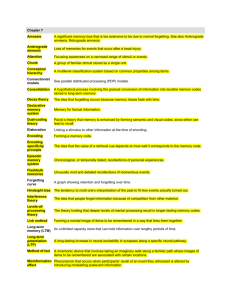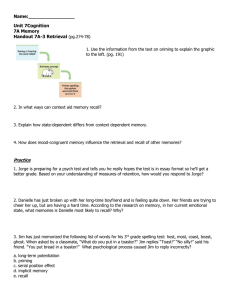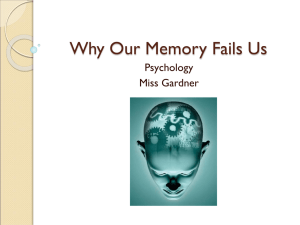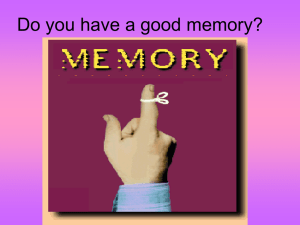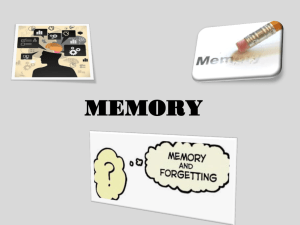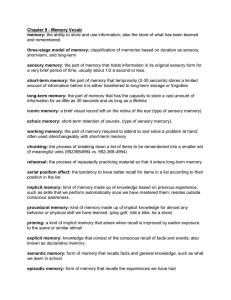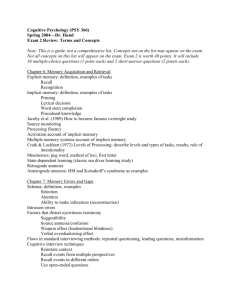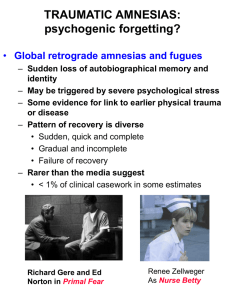Retrieval and forgetting (2)
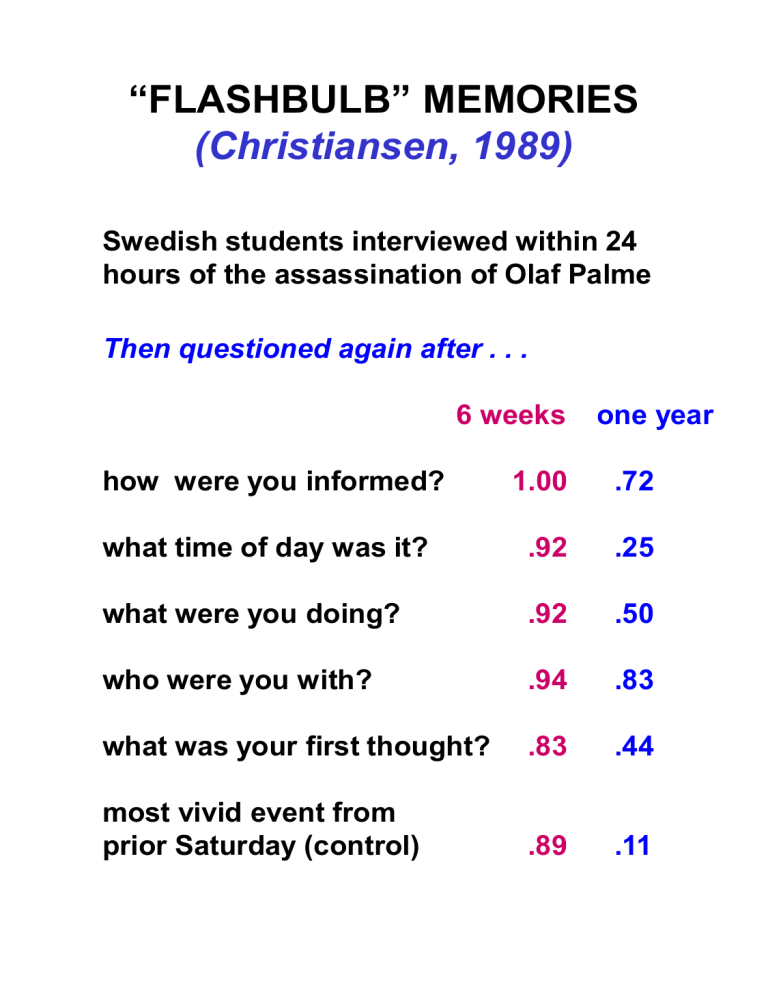
“FLASHBULB” MEMORIES
(Christiansen, 1989)
Swedish students interviewed within 24 hours of the assassination of Olaf Palme
Then questioned again after . . .
how were you informed?
6 weeks one year
1.00
.72
what time of day was it?
what were you doing?
.92
.25
.92
.50
who were you with?
.94
.83
what was your first thought?
.83
.44
most vivid event from prior Saturday (control) .89
.11
MEMORY OVER TIME:
THE FORGETTING FUNCTION
Ebbinghaus (1885): forgetting of list of nonsense syllables
0.8
0.6
0.4
0.2
0
20 min 8 hr 2 days
Retention Interval
31 days
Bahrick & Phelphs (1987): forgetting of Spanish learned in college
100
English-Spanish
80
Spanish-English
60
40
20
0
1 2 5 9 14 25 34 49
Years since class
RECOVERY FROM
“CONCUSSION AMNESIA” time of accident yrs mo day
???????
???
hours later
? ?? ?
?? ?
?
?? ?
days . .
weeks . .
Retrograde
Amnesia
- can be severe
- worse for recent events
- almost complete recovery
Anterograde
Amnesia
- mild to moderate
- worse for events just after trauma
“blank periods” may remain
RECOVERY FROM “ELECTRO-
SHOCK” AMNESIA
• Electroshock Therapy (EST)
– used to treat depression
– can help, with minimal side-effects
– transient amnesia often seen
• Memory following EST (Squire, 1975)
– tests memory for “non-syndicated” TV shows 1964 through 1972
– dramatic “reverse recency” amnesia dissipates as time goes by:
80
70
60 no EST
50 one hr after EST
40
30
'72 one mnth after EST
'70 '68 '66
Year of TV Show
• Ribot’s Law and the process of consolidation
'64
ENCODING SPECIFICITY
PRINCIPLE
How an event is encoded determines the effectiveness of various retrieval cues (Tulving, 1972). Memory will be best if cues/context at study and test are the same task: free recall of word lists
(Smith, Glenberg & Bjork, 1978)
Study in..
Test in..
% recalled office lab office lab 27% office lab lab office 20%
ENCODING SPECIFICITY versus
RECOGNITION > RECALL
(Tulving & Thompson, 1973)
• Study words in context of weak associates:
– glue -- chair
– train -- black etc
• Generate words to strong associates of target words:
– TABLE: desk, chair, flat
– WHITE: black, snow, rain
• Circle any target words:
–
– desk, chair, flat black, snow, rain recognition 29% above chance
• Recall target words, cued by weak associates:
– TRAIN?: black cued recall: 61% correct
ASSOCIATIVE INTERFERENCE
AND FORGETTING task: study and remember lists of paired-associates (A-B)
A B
C learning AC interferes with AB
AB learned first: Retroactive (RI)
AC learned first: Proactive (PI)
RETROACTIVE INTERFERENCE IN
PAIRED-ASSOCIATE MEMORY
(Barnes & Underwood, 1959) task: study and remember lists of paired-associates
10 Trials of AB pairs then
1 to 20 trials of AC pairs
100
80
60
40
20
0
0
"C" recall
"B" recall
5 10 15
# Trials on AC Lists
20 is AB association erased (“unlearned”)?
NO: recognition-matching still good
The War of the Ghosts
(Original Script - Bartlett 1932)
One night two young men from Egulac went down to the river to hunt seals and while they were there it became foggy and calm. Then they heard war-cries, and they thought: "Maybe this is a war-party". They escaped to the shore, and hid behind a log. Now canoes came up, and they heard the noise of paddles, and saw one canoe coming up to them. There were five men in the canoe, and they said:
"What do you think? We wish to take you along. We are going up the river to make war on the people."
One of the young men said,"I have no arrows."
"Arrows are in the canoe," they said.
"I will not go along. I might be killed. My relatives do not know where I have gone. But you," he said, turning to the other, "may go with them.“ (continued…..)
Recalling The War of the Ghosts
•'Something black came from his mouth' tended to become 'he frothed at the mouth', 'he vomited' or
'breath escaped from his mouth'.
•'Hunting seals' tended to become 'fishing'.
•'Canoe' tended to become 'boat' and 'paddles' to become 'oars'.
•The wounded Indian tended to become the hero, whose wounds were sometimes even 'bathed' at the end.
•The reference by the Indian who stayed to the possibility of getting killed tended to be downplayed or dropped, whilst the reference to the probable anxiety of his relatives was usually given greater emphasis (the reference to having no arrows was often omitted).
•The role of 'the ghosts' shifted (for some, they become a clan called the Ghosts; for others they were simply imagined by the Indian when wounded).
REPRESENTATION OF
MEANING IN MEMORY
WHY BOTHER?
for both visual and verbal stimuli,
--comprehension and memory are much better if “meaning” is available: cue target recall without mediator 44% recall with mediator (“pig in fog”) 73%
(Bower et al. 1972)
-- memory for an event appears based more on its meaning than its form:
“do nothing to your / correct answers, but mark / carefully those that are wrong” meaning X : 98%
(Wanner, 1969) style X : 52%
SCHEMAS AS KNOWLEDGE
STRUCTURES
• Represent our knowledge about an
type of object or event
• Captures the general, typical characteristics that define the type
• A concept used by philosophers and computer scientists
• lets us organize, categorize and reason about complex ideas and things
• can facilitate comprehension and inferences
• can lead to bias and “stereotypes”
TYPE OF SCHEMAS
CONCEPTS &
CATEGORIES
-- bird
-- strike
-- women, fire and dangerous things
FRAMES -- office
-- golf course
SCRIPTS -- stories
-- banquets
EFFECTS OF SCHEMATIC
THEMES ON MEMORY
(Owens, Bower & Black, 1979) task: listen to short stories
“Nancy and the Doctor” some are first given an organizing theme
“Nancy wondered if she was pregnant”
No Theme
Mean recall of: presented facts
Theme
29 20 nonpresented inferences 15 4 thematic structure increases both
“exact recall” and reconstructive errors
SOURCE AMNESIA: BECOMING
“FAMOUS OVERNIGHT”
(Jacoby, 1988) task: study faces of famous and unknown people test: recognize studied faces and judge “fame”
Immediate test: few errors
24 hour delayed test: studied, unknown faces falsely classed as not studied but famous
Why?
• The case of John Demjanjuk
– Ukranian immigrant, auto worker in
Cleveland
– On KGB list of German “war criminals”
– Exported and convicted in Israel of being “Ivan the Terrible” of Treblinka
– Fall of USSR, KGB docs forgeries 1991
– Acquitted and released 1993
EYEWITNESS MEMORY
(Loftus, 1978)
• LIMITS OF ENCODING
– stress and arousal may be too high
– attention may be misplaced (“weapon focus”
• POTENTIAL FOR INTERFERENCE
– postevent “misinformation” in interviews, mug shots, etc
• “how fast when they bumped/crashed?”
• PROBLEMS WITH LINEUPS
– who are the “distractors”?
• PROBLEMS WITH HYPNOSIS
– hits may rise, but so do false memories
– increases confidence without accuracy
– other “cognitive strategies” do as well or better
Who do you recognize?
IMPROVING EYEWITNESS
TESTIMONY
The Cognitive Interview
(Fisher & Geiselman, ’92)
- Recreate original context
- Retrieve partial information
- Vary the perspective
- Use mental imagery
- Encourage active role in EW
- Keep focus on relevant dimensions
- Develop rapport, reduce anxiety
Number of crime-relevant facts elicited by trained & untrained detectives
Before trained 26.8
untrained 23.8
After
39.6
24.2
(Fisher, Geiselman & Amador, 1989)
AUTOBIOGRAPHICAL
MEMORY
• Complex mix of episodic and semantic memories
• Organization of AM
– Conway & Rubin’s hierarchical model
• Life Periods around Themes
• General Events and “minihistories”
• Event-specific Knowledge and details
Crovitz & Schiffman, 1974 cue-word recall of AM
TRAUMATIC AMNESIAS: psychogenic forgetting?
• Global retrograde amnesias and fugues
– Sudden loss of autobiographical memory and identity
– May be triggered by severe psychological stress
– Some evidence for link to earlier physical trauma or disease
– Pattern of recovery is diverse
• Sudden, quick and complete
• Gradual and incomplete
• Failure of recovery
– Rarer than the media suggest
• < 1% of clinical casework in some estimates
Richard Gere and Ed
Norton in Primal Fear
Renee Zellweger
As Nurse Betty
• Recovery from Fugue states: a sampler
– Libby Morris: lost from a shopping mall
• Rapid, almost complete recovery
• Amnesia for fugue period
– Ricky Stephenson: AWOL
• Unresolved after two years
• Relearning his past
– Jody Roberts: You’re a thousand miles away
• Unresolved after 12 years
• New, stable identity established
– James Smith: Rip van
Winkle awakes
• Fugue ends after 25 years
• “gap” before recovery
• Amnesia for fugue period
THE MEMORY WARS:
Recovered or False Memories?
The epidemic of “recovered memories” of childhood abuse
Stress-induced global amnesias
Cases of “selective amnesia” and recovery
Lack of credible evidence, strong evidence for “constructive” errors
Lab studies of “false memories”
Cases of “recanting”

